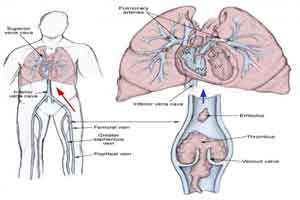- Home
- Editorial
- News
- Practice Guidelines
- Anesthesiology Guidelines
- Cancer Guidelines
- Cardiac Sciences Guidelines
- Critical Care Guidelines
- Dentistry Guidelines
- Dermatology Guidelines
- Diabetes and Endo Guidelines
- Diagnostics Guidelines
- ENT Guidelines
- Featured Practice Guidelines
- Gastroenterology Guidelines
- Geriatrics Guidelines
- Medicine Guidelines
- Nephrology Guidelines
- Neurosciences Guidelines
- Obs and Gynae Guidelines
- Ophthalmology Guidelines
- Orthopaedics Guidelines
- Paediatrics Guidelines
- Psychiatry Guidelines
- Pulmonology Guidelines
- Radiology Guidelines
- Surgery Guidelines
- Urology Guidelines
Imaging only way to diagnose DVT/Pulmonary embolism in pregnancy

Imaging is the only way to diagnose blood clots in pregna Published first in NIHR Signals
No blood test can accurately tell if a pregnant or recently pregnant woman has a blood clot. All pregnant women with a suspected clot should continue to have imaging investigations as per current UK guidelines.
This NIHR-funded study recruited 328 pregnant or postpartum women with a suspected blood clot in the lung (pulmonary embolism) or leg (deep vein thrombosis). They had a blood test to measure the levels of 13 biomarkers, such as the D-dimer, to see if they could rule a blood clot in or out. It was hoped that this could reduce the number of women who would need confirmation from a scan, and so decrease their exposure to radiation.
None of the tests were accurate enough. The range of levels for each biomarker overlapped between women with and without a clot.
Why was this study needed?
Blood clots are the leading cause of death during pregnancy and after giving birth. Between 2012 and 2014 there were 20 maternal deaths due to blood clots in the UK. There are concerns about using CT scans to diagnose pulmonary embolism in pregnant women as only 5% of scans are positive. This could mean that women and their unborn baby are unnecessarily exposed to radiation.
A blood test called D-dimer is used to rule out a blood clot in people who are not pregnant. Those who test positive are then given an appropriate scan. The accuracy of the test is unclear for pregnant women as the level of D-dimer increases throughout pregnancy. This study aimed to see if the D-dimer or other blood tests could be used as a screening tool to reduce the number of women who need a scan.
What did this study do?
The Diagnosis of Pulmonary Embolism in Pregnancy (DiPEP) cohort study recruited 328 pregnant or postnatal women with a suspected blood clot from 11 hospitals in England. Most had clinically suspected pulmonary embolism while 18 had a diagnosed deep vein thrombosis. A blood sample was analysed for 13 biomarkers including D-dimer, prothrombin time, troponin and C-reactive protein.
The researchers followed women for 30 days through medical records, a questionnaire survey or the woman’s GP. The accuracy of blood tests was compared against a diagnosis of pulmonary embolism or deep vein thrombosis confirmed by two independent assessors. They were unaware of blood tests results and made the diagnosis by reviewing imaging results, adverse events and treatments given.
Most women had already been given the anticoagulant heparin before the blood test which may have affected the results.
What did it find?
- Thirty-six women had a clot: 18 with diagnosed deep vein thrombosis, 18 with pulmonary embolism confirmed by imaging and five with pulmonary embolism confirmed on clinical grounds.
- None of the biomarkers were able to accurately predict who did and did not have a clot.
- Average levels of D-dimer tests, thrombin generation, Clauss fibrinogen and plasmin-antiplasmin were higher in women with a clot. However, the spread of levels overlapped across women with and without a clot, so some women with high levels did not have a clot. Setting a cut-off level that maximised sensitivity and ensured they missed as few cases as possible made specificity extremely poor. This meant most women without a blood clot would be wrongly indicated to have one on the basis of these tests.
- Average levels of all other biomarkers tested did not differ between women with and without a clot.
What does current guidance say on this issue?
The 2015 Royal College of Obstetrics and Gynaecology guidelines recommend imaging for any pregnant woman who has symptoms of a pulmonary embolus or deep vein thrombosis. Anticoagulation with low molecular weight heparin should be started while waiting for the imaging results.
A compression ultrasound should be performed for suspected deep vein thrombosis. A chest X-Ray, ECG and either ventilation/perfusion lung scan or a CT pulmonary angiogram should be performed if pulmonary embolism is suspected.
Neither D-dimer nor any other blood test is recommended for screening purposes before imaging for pregnant women.
What are the implications?
The results of this trial do not change current guideline recommendations. However, it seems prudent that women of childbearing age who present with symptoms of a pulmonary embolism or deep vein thrombosis have a pregnancy test as part of the initial investigations in case they are at the early stages of pregnancy.
Citation and Funding
Hunt BJ, Parmar K, Horspool K, et al. The DiPEP (Diagnosis of PE in Pregnancy) biomarker study: An observational cohort study augmented with additional cases to determine the diagnostic utility of biomarkers for suspected venous thromboembolism during pregnancy and puerperium. Br J Haematol. 2018;180(5):694-704.

Disclaimer: This site is primarily intended for healthcare professionals. Any content/information on this website does not replace the advice of medical and/or health professionals and should not be construed as medical/diagnostic advice/endorsement or prescription. Use of this site is subject to our terms of use, privacy policy, advertisement policy. © 2020 Minerva Medical Treatment Pvt Ltd